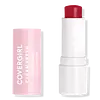What's inside
What's inside
 Key Ingredients
Key Ingredients

 Benefits
Benefits

 Concerns
Concerns

 Ingredients Side-by-side
Ingredients Side-by-side

Polybutene
Hydrogenated Polyisobutene
EmollientOctyldodecanol
EmollientPolyethylene
AbrasiveCaprylic/Capric Triglyceride
MaskingHydrogenated Poly(C6-14 Olefin)
EmollientDicalcium Phosphate
AbrasiveCera Microcristallina
Emulsion StabilisingSynthetic Wax
AbrasiveStearalkonium Bentonite
Gel FormingPentaerythrityl Tetra-Di-T-Butyl Hydroxyhydrocinnamate
AntioxidantPropylene Carbonate
SolventPunica Granatum Extract
AstringentRicinus Communis Seed Oil
MaskingSodium Hyaluronate
HumectantMica
Cosmetic ColorantHydrogenated Castor Oil
EmollientSynthetic Fluorphlogopite
Silica
AbrasiveTin Oxide
AbrasiveIron Oxides
CI 77891
Cosmetic ColorantCI 15850
Cosmetic ColorantCI 19140
Cosmetic ColorantCI 45410
Cosmetic ColorantCI 42090
Cosmetic ColorantPolybutene, Hydrogenated Polyisobutene, Octyldodecanol, Polyethylene, Caprylic/Capric Triglyceride, Hydrogenated Poly(C6-14 Olefin), Dicalcium Phosphate, Cera Microcristallina, Synthetic Wax, Stearalkonium Bentonite, Pentaerythrityl Tetra-Di-T-Butyl Hydroxyhydrocinnamate, Propylene Carbonate, Punica Granatum Extract, Ricinus Communis Seed Oil, Sodium Hyaluronate, Mica, Hydrogenated Castor Oil, Synthetic Fluorphlogopite, Silica, Tin Oxide, Iron Oxides, CI 77891, CI 15850, CI 19140, CI 45410, CI 42090
Tridecyl Trimellitate
EmollientOctyldodecanol
EmollientPolyisobutene
Polyglyceryl-3 Diisostearate
EmulsifyingCandelilla Cera
EmollientCopernicia Cerifera Cera
EmollientBehenyl Behenate
EmollientPolyhydroxystearic Acid
EmulsifyingMentha Arvensis Leaf Oil
MaskingPersea Gratissima Oil
Skin ConditioningButyrospermum Parkii Butter
Skin ConditioningHelianthus Annuus Seed Oil
EmollientSimmondsia Chinensis Seed Oil
EmollientPlukenetia Volubilis Seed Oil
EmollientRicinus Communis Seed Oil
MaskingSodium Hyaluronate
HumectantHydrogenated Castor Oil
EmollientPentaerythrityl Tetra-Di-T-Butyl Hydroxyhydrocinnamate
AntioxidantTocopheryl Acetate
AntioxidantEthylhexyl Palmitate
EmollientTribehenin
EmollientSorbitan Isostearate
EmulsifyingLactic Acid
BufferingPalmitoyl Tripeptide-1
Skin ConditioningTocopherol
AntioxidantPhenoxyethanol
PreservativeLimonene
PerfumingTridecyl Trimellitate, Octyldodecanol, Polyisobutene, Polyglyceryl-3 Diisostearate, Candelilla Cera, Copernicia Cerifera Cera, Behenyl Behenate, Polyhydroxystearic Acid, Mentha Arvensis Leaf Oil, Persea Gratissima Oil, Butyrospermum Parkii Butter, Helianthus Annuus Seed Oil, Simmondsia Chinensis Seed Oil, Plukenetia Volubilis Seed Oil, Ricinus Communis Seed Oil, Sodium Hyaluronate, Hydrogenated Castor Oil, Pentaerythrityl Tetra-Di-T-Butyl Hydroxyhydrocinnamate, Tocopheryl Acetate, Ethylhexyl Palmitate, Tribehenin, Sorbitan Isostearate, Lactic Acid, Palmitoyl Tripeptide-1, Tocopherol, Phenoxyethanol, Limonene
Ingredients Explained
These ingredients are found in both products.
Ingredients higher up in an ingredient list are typically present in a larger amount.
Hydrogenated Castor Oil is created by adding hydrogen to castor oil. This helps stabilize the castor oil and raises the melting point. At room temperature, hydrogenated castor oil is solid.
Castor Oil helps moisturize the skin. It is rich in a fatty acid called ricinoleic acid. This fatty acid helps prevent moisture loss on the skin. This helps keep your skin soft and hydrated. Ricinoleic acid also has anti-inflammatory and pain reducing properties.
As a wax-like substance, Hydrogenated Castor Oil acts as an emollient. Emollients help keep your skin stay soft and smooth by creating a barrier. This barrier helps trap moisture.
Hydrogenated Castor Oil may not be fungal-acne safe. We recommend speaking with a professional.
Learn more about Hydrogenated Castor OilOctyldodecanol is a fatty alcohol. It is primarily used to enhance the texture of products.
As an emulsifier, Octyldodecanol helps prevent the oils and waters from separating. It also prevents ingredients from creating foam when shaken.
Octyldodecanol is created by reducing fatty acid to an alcohol.
Due to its high molecular weight, it does not get absorbed into the skin.
Learn more about OctyldodecanolPentaerythrityl Tetra-Di-T-Butyl Hydroxyhydrocinnamate (long name, huh?) is a synthetic antioxidant.
It is used to help stabilize other antioxidants or prevent the color from changing in a product.
As an antioxidant, it helps fight free-radical molecules. Free-radical molecules are capable of damaging our cells and other genetic material. Thus, antioxidants may reduce the signs of aging.
This ingredient is oil-soluble.
Learn more about Pentaerythrityl Tetra-Di-T-Butyl HydroxyhydrocinnamateRicinus Communis Seed Oil is the INCI name for castor oil.
Castor Oil helps moisturize the skin. It is rich in a fatty acid called ricinoleic acid. This fatty acid helps prevent moisture loss on the skin. This helps keep your skin soft and hydrated. Ricinoleic acid also has anti-inflammatory and pain reducing properties.
Besides hydrating the skin, castor oil is also used to hydrate hair. By keeping the hair shaft moisturized, breakage is decreased. More studies are needed to show castor oil's effective on stimulating hair growth.
Castor oil is created by cold-pressing castor seeds and then purifying the oil with heat. It was used in Ancient Egypt as fuel in lamps and to help treat eye irritation.
The term 'fragrance' is not regulated in many countries. In many cases, it is up to the brand to define this term. For instance, many brands choose to label themselves as "fragrance-free" because they are not using synthetic fragrances. However, their products may still contain ingredients such as essential oils that are considered a fragrance.
Learn more about Ricinus Communis Seed OilSodium Hyaluronate is hyaluronic acid's salt form. It is commonly derived from the sodium salt of hyaluronic acid.
Like hyaluronic acid, it is great at holding water and acts as a humectant. This makes it a great skin hydrating ingredient.
Sodium Hyaluronate is naturally occurring in our bodies and is mostly found in eye fluid and joints.
These are some other common types of Hyaluronic Acid:
Learn more about Sodium Hyaluronate